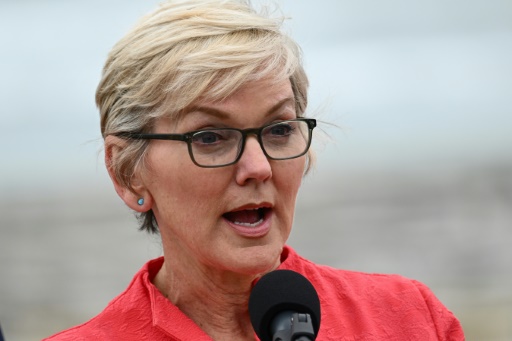The U.S. government will spend up to $1.2 billion for two pioneering facilities to vacuum carbon out of the air, a historic gamble on a still developing technology to combat global warming that is criticized by some experts.
The two projects -- in Texas and Louisiana -- each aim to eliminate one million tons of carbon dioxide per year, equivalent in total to the annual emissions of 445,000 gas-powered cars.
It is "the world's largest investment in engineered carbon removal in history," the Energy Department said in a statement.
"Cutting back on our carbon emissions alone won't reverse the growing impacts of climate change," Energy Secretary Jennifer Granholm said in the statement. "We also need to remove the CO2 that we've already put in the atmosphere."
Direct Air Capture (DAC) techniques -- also known as Carbon Dioxide Removal (CDR) -- focus on that CO2 emitted into the air, which is helping to fuel climate change and extreme weather.
Each of the projects will remove 250 times more CO2 from the air than the largest carbon capture site currently in operation, the Energy Department said.
The U.N.'s International Panel on Climate Change (IPCC) considers capturing carbon dioxide directly from the atmosphere one of the methods necessary to combat global warming.
But the sector is still marginal -- there are just 27 existing carbon capture sites commissioned worldwide, according to the International Energy Agency, though at least 130 projects are under development.
And some experts worry that use of the technology will be a pretext for continuing to emit greenhouse gases, rather than switching more quickly to clean energies.
Direct capture "requires a lot of electricity for extracting CO2 from the air and compressing it for pipes," Stanford University professor Mark Jacobson told AFP.
"Even in the best case, where the electricity is renewable, that renewable electricity is then prevented from replacing a fossil electricity source on the grid, such as coal or gas."
That means such technology is nothing more than a "gimmick," he said, adding: "It will only delay our solution to the climate problem."
Storing CO2 underground
U.S. non-profit Battelle is the prime contractor on the Louisiana project, which will inject captured CO2 for storage deep underground.
It will partner with another American company, Heirloom, and the Swiss firm Climeworks, already a sector leader that operates a plant in Iceland with an annual capacity to capture 4,000 tons of CO2 from the air.
The Texas project will be led by the American company Occidental and other partners, including Carbon Engineering. It could be developed to eliminate up to 30 million tons of CO2 per year, according to a statement from Occidental.
"The rocks in the subsoil of Louisiana and Texas are sedimentary rocks, very different from Icelandic basalts, but they are perfectly viable for storing CO2," Helene Pilorge, an associate researcher at the University of Pennsylvania studying carbon capture, told AFP.
The two projects should create 4,800 jobs, according to the energy department. No start date is yet confirmed for either.
They will be funded by President Joe Biden's major infrastructure bill passed in 2021.
The Energy Department previously announced plans to invest in four projects to the tune of $3.5 billion.
Direct capture differs from carbon capture and storage (CCS) systems at source, such as factory chimneys, which prevent additional emissions from reaching the atmosphere.
In May, the Biden administration announced a plan to reduce CO2 emissions from gas-fired and coal-fired power plants, focusing in particular on this second technique.
© 2023 AFP




8 Comments
englisc aspyrgend
Not sold on the efficacy of these ideas, there financial viability or the long term reliability of the proposed disposal of the captured carbon.
If we truly want to reduce the carbon in the worlds atmosphere then China and India have to stop their huge and growing carbon emissions. Just to highlight the scale of the problem, China has emitted more carbon in the last eight years than Britain has since the start of the Industrial Revolution. China’s annual increase in emissions are greater than Britains total annual output.
Desert Tortoise
I am curious what company you refer to? All of the companies on Secretary Granholm's bio remain in business. None have filed for bankruptcy. She left Talmer Bancorp when it was purchased by Chemical Financial Corporation, which in turn has been merged with yet more firms but remains in business. The other firms who's boards of directors she served on like Dow Chemical (hardly a green energy company), Proterra (manufacturer of electric buses, still in business and recently publicly listed) and Marinette Marine, a Wisconsin based shipyard building warships that will build the new Constellation Class frigates for the US Navy.
The only other woman mentioned above is Hélène Pilorgé, a French born academic who is a Research Associate at University of Pennsylvania and was previously a postdoctoral fellow at the Worcester Polytechnic Institute. She holds a PhD in geology from the University of Lyon (France), where she experimentally studied water-rock interactions in serpentinites under high pressure and high temperature conditions at the subduction zone interface.
So where is all this bankruptcy and criminal activity you mention?
Desert Tortoise
So you are correct about the bankruptcy but can you please show us the fraud? I don't see it.
From what I know on the operational end, BYD buses do not meet their range claims and have a high failure rate. Transit agencies who bought their buses are unhappy. Proterra's buses are lighter and can go farther on a charge than BYDs. Both are made in Southern California btw so labor costs are a wash. Neither company can yet build a bus that can run the longest routes in Southern California on a single charge, which is a problem across the board for electric buses.
It appears from the data in the article that none of the companies are profitable yet. BYD has the Chinese government backing it. Proterra does not. But to accuse them of fraud is a bit over the top when the problems they face are common across their industry.
kohakuebisu
This is a cart before the horse technology.
Reducing emissions reduces CO2 in the atmosphere with 100% reliability. Its as simple as insulating houses, fitting solar panels, driving better cars, and taking trains not planes. None of this is a big hit to anyone's lifestyle.
None of the carbon capture technologies introduced so far works anything like as well as intended. It is therefore just a "we're doing something about it/tech will save us" empty promise. It should not be confused with an actual solution. It would make more sense to reduce emissions, work on capture, and then shift the emphasis away from emissions, or even increase them, once it is guarateed capture works.
tjguy
Biden must have some friends who need some help. Otherwise, why waste money on this "technology" that won't be able to put a dent in the climate change problem - even if it is really a problem! Maybe he just wants to brag that he is doing something?
Total waste. We need to get him out of the White House as soon as possible!
N. Knight
China is number 1 emitter, but the USA is 2nd. India is 3rd.
On a per capita basis, the USA easily beats the other two as the largest polluter.
TaiwanIsNotChina
Thankfully people smarter than you are in charge so you can go about your wasteful lifestyle.
Raw Beer
Yes, and I believe the CO2 produced by the military is not included in their stats. So if you take that into account, their "lead" is even greater.
Yes, that's what they would do if their goal truly was to capture carbon.